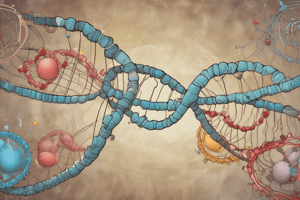Podcast
Questions and Answers
What is the primary function of messenger RNA (mRNA)?
What is the primary function of messenger RNA (mRNA)?
- To bring amino acids to the ribosomes
- To make a strand of nucleotides complementary to DNA (correct)
- To form ribosomes
- To store genetic information
RNA contains Thymine as one of its nitrogen bases.
RNA contains Thymine as one of its nitrogen bases.
False (B)
What are the three parts of a nucleotide?
What are the three parts of a nucleotide?
Sugar, phosphate, nitrogen base
During __________, mRNA is synthesized during protein synthesis.
During __________, mRNA is synthesized during protein synthesis.
Which of the following statements compares DNA and RNA correctly?
Which of the following statements compares DNA and RNA correctly?
A __________ organism is one that has been altered using recombinant DNA.
A __________ organism is one that has been altered using recombinant DNA.
Match the following types of RNA with their primary functions:
Match the following types of RNA with their primary functions:
What is recombinant DNA?
What is recombinant DNA?
Flashcards
Transcription
Transcription
The process by which genetic information in DNA is transcribed into messenger RNA (mRNA)
Translation
Translation
The process by which the genetic code in mRNA is translated into a sequence of amino acids to build a protein
Codon
Codon
A three-base sequence on mRNA that specifies a particular amino acid
Anticodon
Anticodon
Signup and view all the flashcards
Recombinant DNA
Recombinant DNA
Signup and view all the flashcards
Genetically Modified Organism (GMO)
Genetically Modified Organism (GMO)
Signup and view all the flashcards
Nucleotide
Nucleotide
Signup and view all the flashcards
Gene
Gene
Signup and view all the flashcards
Study Notes
DNA Structure and Function
- DNA and RNA are nucleic acids, crucial organic molecules.
- DNA is the molecule that carries genetic information; it's located in the nucleus of eukaryotic cells.
- Genes are segments of DNA that code for specific proteins.
- The monomers of nucleic acids are nucleotides.
- Nucleotides consist of a sugar (deoxyribose in DNA, ribose in RNA), a phosphate group, and a nitrogenous base.
- DNA nitrogenous bases are Adenine (A), Thymine (T), Cytosine (C), and Guanine (G).
- RNA contains Uracil (U) instead of Thymine.
- Base pairing in DNA: A with T, and C with G.
RNA Structure and Function
- RNA differs from DNA in:
- RNA contains Uracil instead of Thymine.
- RNA is single-stranded; DNA is double-stranded.
- RNA sugar is ribose; DNA sugar is deoxyribose.
- Three main types of RNA are crucial for protein synthesis:
- mRNA (messenger RNA): carries genetic information from DNA to ribosomes.
- tRNA (transfer RNA): brings amino acids to ribosomes during protein synthesis.
- rRNA (ribosomal RNA): forms the ribosomes, the protein synthesis site.
Protein Synthesis
- Protein synthesis involves two main steps:
- Transcription: in the nucleus, mRNA creates a complementary copy of a DNA sequence. A three-base-pair sequence in mRNA is known as a codon.
- Example: DNA: TAC GGG GTG ATG; mRNA: AUG CCC CAC UAC.
- Translation: occurs at the ribosome in the cytoplasm. tRNA brings amino acids to the ribosome, matching their anticodons to the mRNA codons. Amino acids bond together forming a polypeptide chain which becomes a protein.
- Example: mRNA codons: AUG CCC CAC UAC; tRNA anticodons: UAC GGG GUG AUG; amino acids: met - pro - his - tyr
- Transcription: in the nucleus, mRNA creates a complementary copy of a DNA sequence. A three-base-pair sequence in mRNA is known as a codon.
- Understanding the mRNA codon table is essential for determining the resulting amino acid sequence.
Genetic Engineering
- Genetic engineering involves intentionally altering DNA to modify an organism's characteristics.
- Recombinant DNA: combining DNA from two or more different organisms.
- Genetically modified organism (GMO): an organism altered using recombinant DNA, such as bacteria producing human insulin.
- Bacterial plasmid: a circular DNA molecule found in bacteria, utilized in recombinant DNA techniques.
- Viral vector: a modified virus used to deliver genes into cells.
- CRISPR-Cas9: a revolutionary gene-editing technique, derived from bacteria, and involves cutting DNA at specific locations using an RNA guide. CRISPR is made of two parts: an enzyme (Cas9) that cuts DNA, and a piece of RNA (guide RNA) that guides the enzyme to the target location in the DNA chain to edit it.
Studying That Suits You
Use AI to generate personalized quizzes and flashcards to suit your learning preferences.




